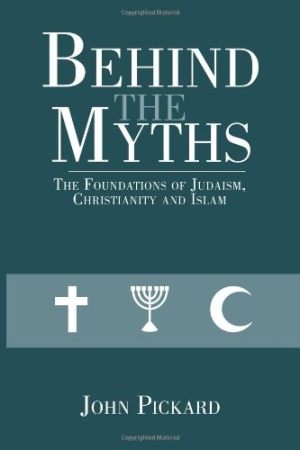Behind the Myths
The Foundations of Judaism, Christianity and Islam
“This book is intended to be neither an insult nor a comfort to the faithful,” says John Pickard in his well-researched work examining the origins of Judaism, Christianity, and Islam. Rather, he calls Behind the Myths “an unashamed guide for the unbelievers,” a discussion about how and why these faiths began, evolved, and were corrupted by the elite for their imperial ambitions. This work presents a well-supported argument for how religion arose in response to specific economic and social conditions, reflecting—rather than responsible for—changes to the larger society.
The three great religions, Pickard writes, originated as revolutionary movements by the oppressed. The first real Israelites, says Pickard, quoting another author, were “a collection of antisocial renegades; castoffs from society who maintained a semi-independent community.” Known as the Apiru—from which the word “Hebrew” may have evolved—these “gypsy-like” people rose up against the Egyptian province of Canaan, where they lived sometime around the thirteenth century BCE (Before the Common Era).
These rebels adopted the cult of Yahweh from another local people, the Shasu, and this evolved into “the ideological binding that held together the disparate groups” that eventually formed the kingdoms of Israel and Judah. Pickard says it was only after those kingdoms were conquered by the Assyrians and the Babylonians some four and five centuries later that the Torah and the rest of the Old Testament were codified. It was not until Judah was restored as a puppet state of the Persian Empire, explains Pickard, that this faith “completed its long march from being a cult with revolutionary overtones to one that was honed and refined to become the official state religion of the Persian-sponsored Jewish elite.”
Christianity also started as a reaction by the oppressed, beginning as a rebellion against the authority of the Jewish and Roman elite, the author says. The early Christian writings are “the literature of revolution” and “class struggle.” Christianity evolved into what he terms “Judaism-lite” only to be co-opted by the Emperor Constantine, whose famed conversion Pickard presents as more a matter of “political calculation” than faith. From this stemmed “the first possible world religion,” as Pickard describes the Roman church.
Pickard never attacks the tenets of either of these faiths, nor that of Islam, to whose origin in “class conflict” and rise to imperial status he devotes the third of the three parts of the book. To the contrary, Pickard often praises the good intentions and noble aspirations of the originators of these philosophies. While as an atheist he does not believe in gods or religion, neither does he attack or debunk them. Rather, this is an examination of the world in which the creators of those philosophies lived, and how and why over the course of history they embellished and built upon their beliefs to create powerful theocratic institutions.
The author has compiled a lengthy and impressive bibliography of historians and philosophers from whose works he quotes, providing footnotes as a reference. He gives more chapters and pages to Christianity and Islam than to Judaism, but restores that balance through the four appendices, the last of which compares how each of the faiths initially dealt with the issue of slavery.
Behind the Myths is more a work of history and archeology than of religion, and while controversial in the challenges it presents to those who take their religious texts literally, it is a scholarly, even-handed, respectful, and serious examination as to who wrote those texts—and why.
Reviewed by
Mark McLaughlin
Disclosure: This article is not an endorsement, but a review. The publisher of this book provided free copies of the book and paid a small fee to have their book reviewed by a professional reviewer. Foreword Reviews and Clarion Reviews make no guarantee that the publisher will receive a positive review. Foreword Magazine, Inc. is disclosing this in accordance with the Federal Trade Commission’s 16 CFR, Part 255.

